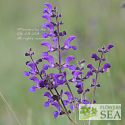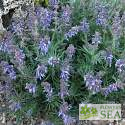(Mount Olympus Sage) The deep violet and white flowers of Salvia ringens are eyecatching. Their wiry, branched spikes rise up to 5 feet tall from a dark green basal rosette.
Ringens refers to the gaping look of the sage's two-lipped flowers, which bloom from summer into fall. Another notable characteristic about the plant's appearance is the fernlike look of its slightly gray foliage.
This cold-hardy sage grows well in USDA Zones 6 to 9. It is endemic to the mountainous Balkan countries of Southeastern Europe, which means those are the only places to which it is native. As its common name indicates, the largest concentration is on Greece's Mount Olympus -- the mythological home of the Titans.
This sage is easy to grow. Give it full sun, good drainage and loamy but not-too-rich soil. Although it does well in dry gardens, this sage needs at least occasional summer watering and more while becoming established. Winter mulch is necessary in the coldest zones.
Gardeners in the UK have grown Mount Olympus Sage in perennial borders since at least 1913. However, it has never become popular in the United States. We think this needs to change!
Highly recommended!
Question?








